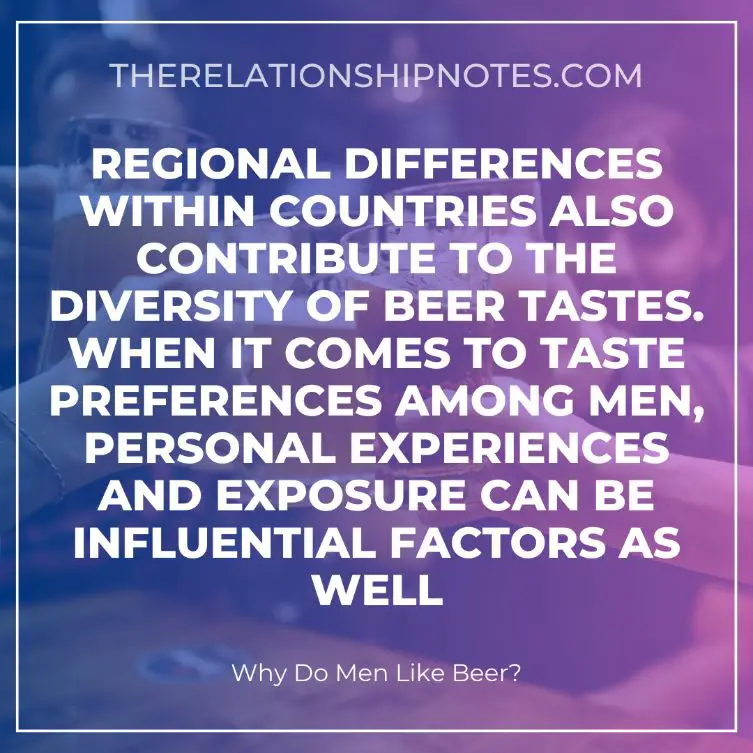Beer has been a staple in the lives of men for thousands of years.
Table of Contents
From ancient civilizations to modern day, beer has remained a popular beverage among men across the globe.
But why do men have such an affinity for this frothy brew?
As a beer historian and writer, I’ve spent countless hours researching and analyzing the history of beer consumption among men.
One reason for the popularity of beer among men is its taste.
Beer often has a bitter flavor profile that appeals to many male palates.
This bitterness comes from hops, which are added to balance out the sweetness of malted grains used in brewing.
Additionally, many beers have complex flavors that can be appreciated by those with more refined tastes.
Men enjoy exploring different types of beers and discovering new favorites, making it not only a drink but also a hobby.
Summary
- Beer has been a staple in men’s lives for thousands of years, enjoyed for its taste and complex flavors.
- The history of beer is rich and has had a significant impact on human civilization and economies.
- Understanding how beer is made, including the use of malted grains and hops, enhances appreciation for the beverage.
- Taste preferences among men vary, influenced by cultural factors and personal experiences.
- The social aspect of beer drinking, including beer bonding and pub politics, adds to its appeal. However, it’s important to consume beer in moderation to balance its potential health benefits and risks. The rise of craft beer and beer tourism has brought new flavors, styles, and culinary experiences to the world of beer.
A Brief History Of Beer
Beer is an age-old beverage that has been around for thousands of years.
Its influence on human civilization is undeniable, as it has played a significant role in the social and cultural development of many societies throughout history.
This alcoholic drink was first brewed by ancient civilizations such as the Sumerians, Egyptians, and Chinese, who used it to celebrate religious ceremonies and mark important occasions.
The economic impact of beer cannot be overstated either.
Beer production and consumption have had a profound effect on economies worldwide since its inception.
In fact, some historians argue that beer may have been one of the key factors behind the rise of early civilizations due to its ability to sustain large populations with safe drinking water during times when other sources were scarce.
As time progressed, so did beer brewing techniques and recipes.
From medieval monasteries to modern microbreweries, beer remains a staple beverage enjoyed by people all over the world.
Today’s diverse selection of beers reflects both traditional brewing methods and innovative experimentation with new ingredients and flavors.
It seems clear that while our love for this frothy brew might not ever fully subside, we can expect even more exciting developments in the world of beer-making in the future.
More Articles:
How Beer Is Made?
Ah, the drink of the gods.
The beverage that men have been enjoying for thousands of years: beer.
But how exactly is this beloved drink made?

Firstly, let’s talk about home brewing techniques – a practice dating back to ancient civilizations.
Homebrewers used simple methods such as boiling grains in water and adding natural yeasts from the air to create their brews.
As technology advanced, so did brewing techniques.
Today, modern breweries use complex equipment like mash tuns, fermenters, and filtration systems.
However, with increased production comes an environmental impact.
Beer production requires large amounts of water and energy consumption which can contribute to pollution and climate change.
That being said, many breweries are now implementing sustainable practices such as using renewable energy sources and recycling wastewater.
To truly appreciate beer, it’s important to understand its history and craft.
Whether you’re sipping on a crisp pilsner or indulging in a hearty stout, take a moment to consider the time-honored tradition behind your glass.
And next time you crack open a cold one, raise a toast to both the craftsmanship that went into making it and Mother Nature who gave us everything we need for its creation!
Why I love beer:
- Brings back memories of good times with friends
- The perfect complement to savory foods
- Wide variety of unique flavors
- Reasons why we should care about sustainability in beer production:
- Protecting our planet for future generations
- Supporting eco-friendly businesses
- Ensuring access to clean drinking water
How You Can Make A Difference:
- Choose beers from environmentally-conscious breweries
- Reduce overall alcohol consumption
- Educate others on the importance of sustainable living – Support organizations and initiatives that promote conservation and protection of natural resources.
The Many Types Of Beer
Now that we’ve learned about the intricate process of beer-making, it’s time to delve into the different types of beer.
Did you know that there are over 100 different styles?
From pale ales to stouts and everything in between, each type has its own unique flavor profile and history.
Beer pairing is an important aspect when enjoying this beverage.
Certain beers complement certain foods better than others, enhancing both the taste of the food and the drink.
For example, a light lager pairs well with seafood dishes while dark beers like porters or stouts go great with chocolate desserts.
Regional variations also play a significant role in the world of beer.
Each country has its own specialties and brewing techniques that have been passed down for generations.
In Germany, for instance, they’re known for their crisp pilsners while Belgium boasts some of the best Lambic beers in the world.
Exploring these regional differences can add a whole new level of appreciation to your love of beer.
Taste Preferences Among Men
Beer has been a favorite beverage for men throughout history.
Taste preferences among men have evolved over time, but beer remains a popular choice due to its unique flavor profile and cultural significance.

From light lagers to dark stouts, there is a wide variety of beers available that cater to different taste preferences.
Cultural influences play a significant role in shaping taste preferences among men.
For instance, German and Belgian beers are known for their distinct styles and flavors.
These countries have long-standing brewing traditions dating back centuries, which have influenced the way people perceive beer worldwide.
In addition, regional differences within countries also contribute to the diversity of beer tastes.
When it comes to taste preferences among men, personal experiences and exposure can be influential factors as well.
Some may prefer hoppy IPAs while others enjoy malty amber ales or fruity wheat beers.
Brewing techniques and ingredients used by breweries can also influence the final product’s taste.
Factors such as water quality, yeast strains, and aging methods all contribute to creating unique flavor profiles.
Understanding the various factors that influence taste preferences among men highlights how complex this topic really is.
Ultimately, one’s preference for beer is subjective and varies from person to person based on individual palates and experiences.
The appreciation of beer goes beyond just its taste; it encompasses culture, tradition, and socialization – all contributing factors that make it an enduringly beloved drink around the world.
The Role Of Hops In Beer Flavor
As we have discussed in the previous section, taste preferences among men play a significant role in their love for beer.
However, there is another key factor that cannot be ignored when examining this phenomenon – the role of hops in beer flavor.

Hops cultivation can be traced back to ancient civilizations such as Rome and Greece, where it was used for medicinal purposes before its use in brewing.
It wasn’t until the Middle Ages that hops became widely recognized as an integral ingredient in beer production due to its preservative properties and ability to balance out sweetness with bitterness.
Today, there are numerous hop varieties available including Cascade, Centennial, and Saaz which all contribute unique flavors and aromas to different beers.
Some may prefer the floral notes of Cascade hops found in American pale ales while others may enjoy the spicy characteristics of noble hops like Hallertau or Tettnang found in German lagers.
The complexity and diversity of hop flavors have undoubtedly contributed to the enduring popularity of beer among men.
Whether it’s the bitter bite of an IPA or the smooth finish of a pilsner, each brew offers a distinct experience thanks to the careful selection and utilization of hops by brewers worldwide.
The Importance Of Malted Grains
The science of malting is one of the most important aspects in the brewing industry.
Without malted grains, we wouldn’t have beer as we know it today.
Malted grains provide the necessary sugars and enzymes needed for fermentation to occur.
The process starts by soaking barley in water for a few days until they start germinating, then drying them out with hot air using kilns or ovens.
Craft beer has made great strides over the past decade, and malted grains have played an essential role in this revolution.
Brewers are now experimenting with different types of grains such as wheat, rye, oats, and even corn.
These ingredients bring new flavors and aromas that complement hops and yeast perfectly.
Malted grains also contribute to the color and body of beer.
Depending on how long they’re roasted, they can produce anything from pale golden hues to deep dark browns almost black like stout beers.
Moreover, different levels of roasting affect how much sugar is available during fermentation—lighter roast gives more fermentable sugar while darker ones give less but add complexity to flavor profiles.
Craft brewers love exploring these nuances when creating unique brews that stand out from mass-produced beers that rely heavily on adjuncts like rice or corn instead of quality malted grains.
The Science Of Brewing
The art of brewing beer has been around for thousands of years.
From ancient civilizations to modern times, people have enjoyed the taste and effects of this beloved beverage.

But what makes beer such a popular drink among men?
The answer lies in the science behind its creation.
Brewing equipment plays a crucial role in producing high-quality beer.
From mash tuns to boil kettles, each piece of equipment must be carefully designed and maintained to ensure optimal flavor and consistency.
Even the smallest details, like the shape and material of the fermenter, can impact the final product.
A skilled brewer knows how to manipulate these variables to create unique flavors that will satisfy even the most discerning palate.
Of course, no discussion on beer would be complete without mentioning fermentation.
This process is where yeast converts sugars into alcohol and carbon dioxide, giving the beer its signature buzz and bubbly texture.
Different strains of yeast produce different flavors and aromas, which is why brewers are always experimenting with new combinations.
And while there are many factors that influence fermentation — including temperature, oxygen levels, and pH balance — it ultimately comes down to patience and precision.
Beer may seem like a simple pleasure, but it’s actually a complex blend of science, artistry, and tradition.
By understanding the intricacies of brewing equipment and fermentation processes, we can appreciate all that goes into making this beloved beverage.
So next time you crack open a cold one with your buddies, take a moment to appreciate the centuries-old craft that went into creating it.
Beer Culture And Tradition
As a beer historian and writer, it is fascinating to explore the cultural significance of beer in different societies.
Beer culture has been an integral part of many traditions for centuries, with social rituals that bring people together over a cold pint.
In ancient civilizations such as Egypt and Mesopotamia, beer was considered a gift from the gods and played an essential role in religious ceremonies.
In medieval Europe, brewing was often done by women at home until it became more commercialized.
Some monasteries even had their own breweries to sustain themselves and provide hospitality to travelers.
Beer culture today continues to evolve, with new trends emerging alongside traditional practices.
From craft beers to microbreweries, there are countless ways for enthusiasts to connect over their passion for this beloved beverage.
Whether enjoying a pint after work or attending a festival dedicated solely to beer, social rituals around beer continue to unite communities across the globe.
Beer culture and tradition have come a long way since its early beginnings but remain an important aspect of our world’s diverse heritage.
Its significance extends far beyond just being another alcoholic beverage; rather, it embodies history, community gathering, and enjoyment shared among friends old and new alike.
The Social Aspect Of Beer Drinking
It’s not just the taste of beer that draws men to it.
There is a social aspect to drinking beer that has been ingrained in cultures all over the world for centuries.

In fact, throughout history, drinking beer has been used as a way to bond with others and build relationships.
Beer bonding happens when people come together over a cold pint at their local pub or bar.
It’s an opportunity to catch up with friends, relax after work, and share stories from the day.
The atmosphere is casual and laid-back, which allows for easy conversation and connection.
For many men, this type of social interaction is invaluable.
But it’s not just about having a good time; there are also politics involved in the pub scene.
Pub politics refer to the unwritten rules and codes of conduct that govern behavior in these spaces.
These can include things like taking turns buying rounds of drinks, respecting each other’s opinions during discussions, and avoiding controversial topics that could cause arguments.
Understanding these dynamics is essential for fitting into the community and building lasting friendships.
In summary, while the taste of beer may be enough to draw some men in, it’s often the social aspects surrounding its consumption that keep them coming back for more.
Beer bonding provides an opportunity for meaningful connections with others while understanding pub politics ensures that everyone feels comfortable and respected within the group.
So next time you raise a glass with your buddies, take a moment to appreciate the rich cultural tradition behind this beloved beverage.
Health Benefits And Risks Of Beer Consumption
After discussing the social aspect of beer drinking, let’s now delve into another interesting facet – the health benefits and risks associated with its consumption.
While beer has been a staple beverage for many centuries, it is not without its potential drawbacks.
However, when consumed in moderation, it can also provide several advantages.
Firstly, studies have shown that moderate beer consumption can lower the risk of heart disease by up to 40 percent.
Beer contains antioxidants and flavonoids which help reduce inflammation and prevent blood clots from forming.
Additionally, it may also improve cholesterol levels and decrease blood pressure.
On the other hand, excessive alcohol intake can lead to various negative effects on one’s health such as liver damage, mental disorders and even cancer.
It is important to note that moderation is key when it comes to consuming beer or any alcoholic beverage.
According to dietary guidelines set by the U.S. government, men should limit their daily intake of alcohol to two drinks per day while women should only consume one drink.
To better understand how much alcohol content each type of beer holds per serving size, refer to this table below:
| Type of Beer | Serving Size (oz) | Alcohol Content (%) |
|---|---|---|
| Lager | 12 | 4-5 |
| Stout | 16 | 6-8 |
| IPA | 12 | 6-7 |
In summary, there are both benefits and risks associated with drinking beer but they ultimately depend on one’s level of consumption.
Drinking excessively poses serious threats to our health while enjoying a few beers every now and then may actually be beneficial.
As always, remember to practice responsible drinking habits!
Exploring The World Of Craft Beer
Beer has been a staple in the lives of many men for centuries.
The history of beer dates back to ancient civilizations where it was consumed as a daily beverage.
It wasn’t until the late 20th century that craft breweries started popping up, revolutionizing the way people perceive and enjoy beer.
One aspect that has contributed significantly to the rise of craft beer is beer tourism.
People are traveling far and wide to visit breweries and taste various types of beers.
This movement has led to an explosion in microbreweries, creating unique flavors and styles not found anywhere else.
Beer tourism also presents an opportunity for enthusiasts to learn about the brewing process, see how their favorite beers are made, and meet like-minded individuals.
Another factor contributing to the popularity of craft beer is pairing it with food.
For years, wine was considered the go-to drink when trying to complement food’s flavor profile; however, this concept is changing rapidly.
Craft brewers have taken on the challenge of creating beers specifically designed to pair well with different dishes – from light pilsners paired with seafood to robust stouts matched with chocolate desserts.
The result is a culinary experience unlike any other.
Beer continues to be a beloved drink among men worldwide because its versatility allows for endless experimentation while still delivering quality taste every time.
Whether you’re sipping on your favorite brew at home or exploring new ones during your travels, there’s no denying that drinking beer is more than just quenching thirst – it’s a cultural phenomenon worth experiencing firsthand!
More Guides:
Do Guys Know When They Met The One
Would A Guy Text You Everyday If He Wasn’t Interested
Conclusion
So, there you have it – the myriad of reasons why men (and women too!) enjoy a good beer.
From its rich history and diverse brewing methods to the unique tastes and cultural traditions that surround it, beer has become an integral part of our social fabric.
As a self-proclaimed beer historian and writer, I can attest to the fact that there is always something new and exciting to discover in the world of brews.
Whether it’s trying out different styles or exploring local craft breweries, there is no shortage of ways to expand your palate and deepen your appreciation for this beloved beverage.
So go ahead, grab yourself a cold one, and cheers to the timeless allure of beer!
